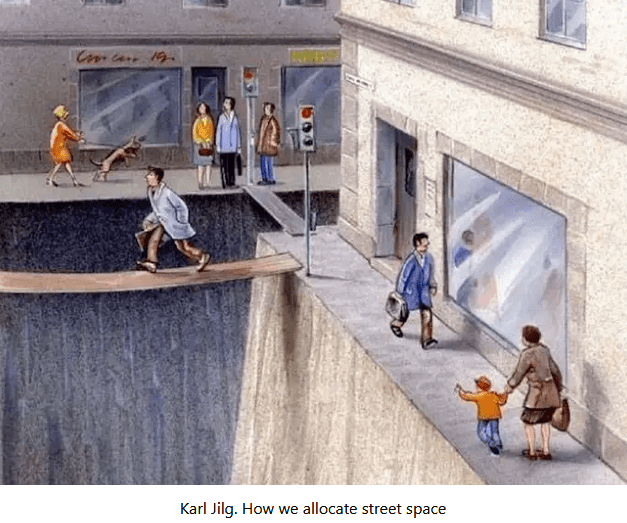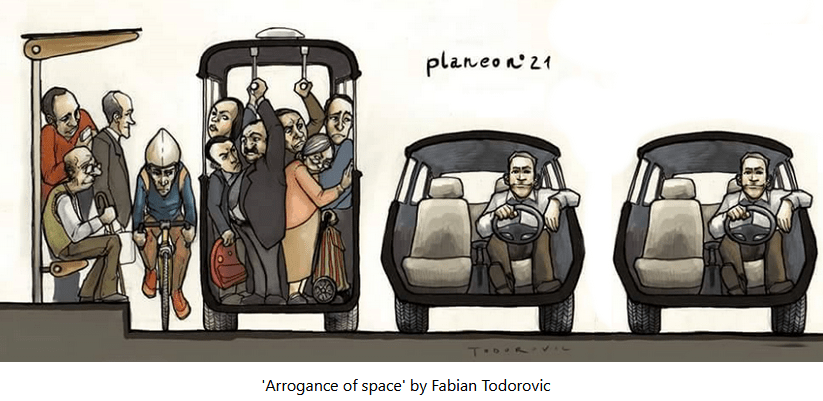„If you can’t see the expansion of cycling as part of the solution, you are the problem yourself” says Mikael Colville-Andersen, here with daughter Lulu-Sophia. „No one was successful trying to squeeze bicycles into the existing matrix of car-centric planning. You must reallocate the space. Cars are in there now. But not for long”. Mobility expert Mikael talks to Rafał who is trying to find out whether and how Warsaw can learn from his experiences.
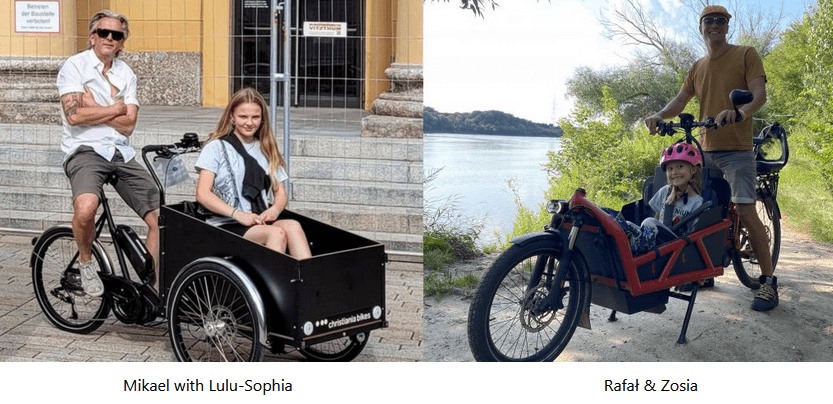
RAFAŁ: Do you ever get tired – or bored – of Copenhagenizing cities?
MIKAEL: Good question (laughing aloud)! I think I do get bored of repeating myself for the past 15 years. But that’s what you have to do. You have to repeat yourself, until more and more people realize that what you are saying is true and necessary. I get bored with cities that continue to make baby steps. Bored with the cities that don’t make this big leap into the future which we know is easy, accessible and possible.
I haven’t really been doing much “copenhagenizing” recently, apart from just being interviewed on the subject. I have my global TV series “The Lifesized City” which took most of my focus in the last 3 years. I left the company – Copenhagenize – in 2019. I work on certain projects as a consultant, but only if the client is visionary and really ready to change the urban landscape physically within a short period of time. I don’t think I get tired of this. This is sort of a journey I have chosen. And I am this guy who talks about it globally. I don’t think I get tired of this. It just gets boring sometimes when it’s going too slow. But I am an impatient idealist so it’s never gonna be fast enough for me. And because I have seen cities do it and transform in such a short time. So I know that’s possible.
You have visited Warsaw before. What was your impression of the Polish capital city?
Yes, I have. The life is obviously better than in the 1990s when I was in Warsaw previously. But if you think of urban mobility, Warsaw was better in the old days than it is now. Everybody started buying cars in the 90s – it was the East Bloc way to go – so the authorities allowed even more space for these cars. And then it started. It was much nicer to move around Warsaw in 1990 compared to what it’s like today.
But, come on, I like Poland. I always had a big crash on Poland. Whether it is talking about cargo bikes or Copenhagenizing, or earlier on Cycle Chic…Poland just embraces everything. The first country to translate my book “Copenhagenize” was Poland and I was very pleased with that. Warsaw has some really cool neighbourhoods, but when you look at the big streets and large squares, that’s where everything goes wrong. Because you just focus on the automobiles. And then you have the cars battling with trams and all the pedestrians having difficult time walking across intersections and pavements, because – oddly enough – cars are parked there. And finally you have the rise of cyclists who need more space too.
I always try to be positive right, but…you know, you have amazing public transport. You have wide streets. You have population in the city enter who is happy to walk and cycle there.
You have a lot of options here and implementing the bicycle culture isn’t as difficult as it can be in many cities in America. But it does require that you are re-democratise and reallocate the street space from cars over to more intelligent transport forms. There is potential, Warsaw. Use it.
And I have lots of friends from Warsaw on WhatsApp so for me it’s also a great city because of that.
In your keynote speeches you flag „Paradigm Shift” often. Can you explain what that is and does Warsaw need one?
(Laughing out loud). Does Warsaw need one? F**k, yeah! Every city needs one. We’ve been living together in cities for 7 thousand years now. By and large it was the same. All over the world. Direct planning and catering for the needs of citizens and residents. Then the cars came along. In the US, in the 1920s – here in Europe it was the 50s – and in the Eastern Europe it came later of course. The paradigm shift when the automobiles started moving to our cities was absolutely massive. The greatest paradigm shift ever in the history. It changed everything. The streets were democratic space before. We all hang up there. We did everything out there. And then, the car came along and completely transformed perception of our streets. There’s never been a paradigm shift which was greater and more destructive in the history of our cities.
So, it’s time. Time to go back to the future. Time to convert that paradigm shift into something more intelligent and human. Make drastic reduction in the number of cars in our cities. Like some cities are currently doing. Paris, for instance. Paris is a darling. They are doing everything possible to restrict car traffic. Oslo is another one. Seville in Spain was a darling 10 years ago. Going from 0.2% on bicycles to 7% in only 4 years! Purely because cycling infrastructure fell out of the sky. That was the paradigm shift you need. And yes, again, Warsaw needs one. We need that visionary political decision-making which you are now lacking. Political visions on how to improve public health and life in the city.
Will the paradigm shift come with hate, anger and resistance? How do you manage it?
Yes, it will. But you just ignore it. When politicians started to implement anti-smoking laws all over the world, they never invited tobacco companies and cigarette smokers to the table to ask their opinion. We just did it. The hammer fell. Boom! You can’t smoke inside anymore. This is a public health issue. An illness of the society. So, some people were pissed. Who cares? Doesn’t matter. Motorists in the city getting angry? Who cares. It’s not about them anymore. They’ve had their time. They’ve had 70 years of transportation dictatorship in the city and now it’s time for us to re-democratize our streets and get our cities back. Do you really care if your enemy is angry? Because you are trying to make things better? No. You don’t care. You just do it. And you do it hard and you do it fast.
We’re talking about the carrot and stick here. The carrot is to encourage people and that is cycling infrastructure, wider sidewalks, better public transport with priority in traffic. And the stick is making the city inaccessible for cars. Making it difficult and increasingly expensive to move your car around the city. Forcing people to change their behaviours to seek out faster solutions and different ways around the city.
Most cities have the best cycling infrastructure around the city center. Warsaw may seem opposite. “Centrum” lacks infrastructure most. Very often, parking spots and wider streets remain prioritised and are what residents care for more still. What is your advice to the authorities on how to manage these – clearly unhealthy – expectations and drive the necessary change for the greater good?
You have space. Hah! Sometimes I ask politicians. Don’t you care about the health of your residents? Do you hate children? It’s really that. If you continue to plan for cars, you do absolutely nothing for public health. You continue to make your residents ill. And kill them. I do not think what kind of politician may consider this a good idea, unless you are dealing with an evil dictatorship. My advice to the authorities? Stop doing it. This is 2021. If you can’t see the expansion of cycling as part of the solution to make our cities better, you are the problem yourself. It’s that simple. We know that every time you make more space for cars – more parking spots, wider road, another motorway – you always get more cars than you started with. That’s why you never make more space for the existing cars. Because the number of cars always increases. It’s called induced demand. This is the best-known truth in traffic planning which was absolutely confirmed in the last 100 years all over the world.
Authorities must focus on the city you want in the future and not about the city you want to park your private car in today, right now, just because you own a car! It is not just about visionary planning. It is about improving public health. Envisioning a city that can be better. And there is no city which can be better with more cars. Or even the number of cars we have today. It’s about reducing their number drastically as so many cities around the world are now doing.

To increase the modal share of cycling, we need infrastructure. Can Warsaw develop cycling infrastructure without narrowing the roads and elimination of parking spaces? Or we cannot eat and keep this cake?
No (putting down his coffee cup with force)! What is a street? It’s all that space between the facade of one building and the other on the opposite side. That is public space. And what we do in that space determines what kind of vision we have in the city hall. The streets have morphed back and forth. They changed drastically throughout centuries so we can certainly do it again. There’s lots of space. It’s just how you want to use it. There is no one in the world who was successful trying to squeeze bicycles into the existing structure and matrix of car-centric planning. It simply isn’t possible. The only way to do it is to reallocate that space. Redemocratise that street space and give bicycles wide infrastructure which must be unidirectional on both sides of the street. But it’s not just about the bikes. It’s about planting trees, putting out some benches. The car parking spaces can be used so much more efficiently for public life, as well as bicycle transportation and wider sidewalks. You require space to improve transportation and quality of life but luckily, space is something you had loads of. Only that cars are in there now. But not for long.
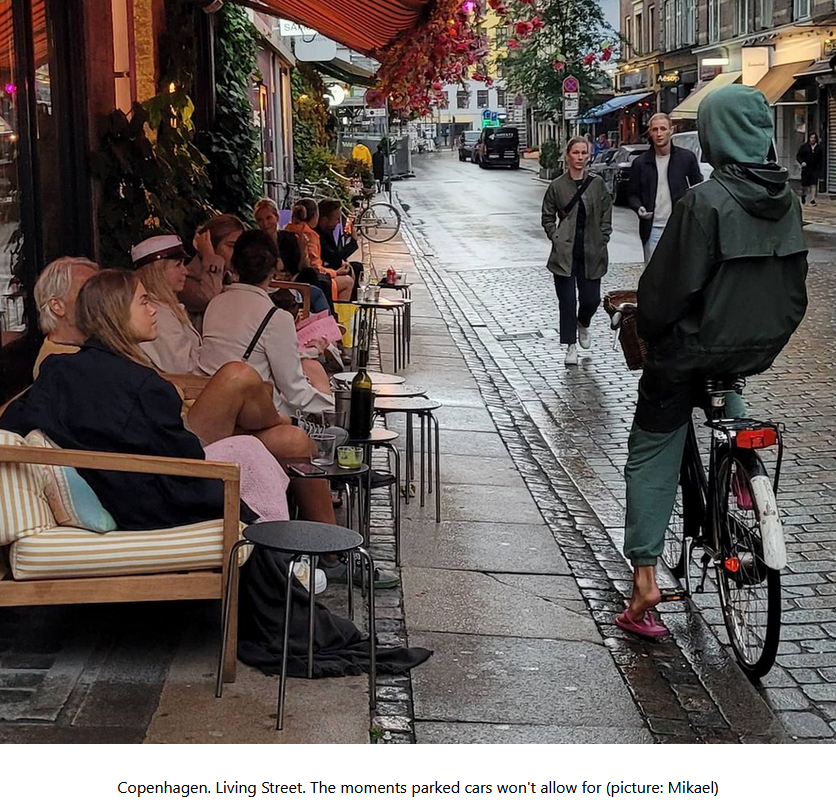
Are you familiar with the progress Warsaw claims to have made in cycling infrastructure over recent years?
Yes. I’m pretty familiar with what most cities are doing around the world. Unfortunately, it’s not that great in Warsaw, especially compared to how much talk they are doing and considering how many great activists are there. But I don’t see anything drastic. There is actually nothing that impresses me at all to be honest. So that sucks, Warsaw.
What do you think about the idea of mixing cyclists and pedestrians without physically separating them? I’m talking about merging the pavement walking and cycling path into a single route, which is quite popular in Warsaw. Would you ever arrange a pavement-laid cycling path or permit cycling on pavements?
No. That’s stupid. Bicycle infrastructure has been around for more than a century. In 1915 here in Copenhagen – not far from where I’m sitting – they implemented a simple idea of physically separating bicycles from the roadway and pedestrians, giving cyclist their own dedicated space. Because cyclists do not mix with pedestrians. Yes, it is true there are some examples in parks along the Copenhagen harbour where we have some mixed-use paths, but it’s only when we really have no other option and always for a very short distance connection. Everywhere else we separate the bicycles from pedestrians. Mixing of the two is completely stupid. And we’ve known this for at least 100 years. And yes, we have tried some weird theories in the meantime and since they never worked, we are sure not to try them again. Same in the Netherlands. We should not be cycling on the sidewalk. Cyclists should be given good asphalt on separated infrastructure protected from the roadway and the sidewalk. Not “out of the door” zone on the wrong side of the parked cars too. Believe me. We know where to put the infrastructure. Everything has been figured out. There is no question how to design a city for the bikes. It’s all copy-paste ready from the best of Danish practice. Very simple. Give cyclist the space that they require and that they deserve. And let pedestrians do their thing as well. Tram lines in Warsaw are amazing. Bus lanes are amazing. All these things work. They are most efficient in moving people down the street. And we know that if we have the best practice bicycle infrastructure – like we have in Copenhagen – we can move 5900 people per hour down the street by bicycles alone. This is simply Danish pragmatism. It’s the math. We can only move 1300 people in cars at the same time in one car lane. So, we know that if we have good infrastructure for bicycles, we will be moving people efficiently to the city. Getting them to work on time, to the supermarket for shopping or to the kindergarten to pick up their kids or evening entertainment, or any other things they might do. You do not downgrade that by mixing with pedestrians. You respect the fact that bicycles are incredibly efficient as transport and you do everything you can to prioritize that.
Do you have experience of cities haunted by their ghastly East Bloc urban design past and the subsequent car-centric present, which managed to turn the tide and develop quickly into livable cities? If yes, how did they achieve that?
Yeah. Well, ghastly urban design in the Eastern Europe is a conversation we might have over a bottle of wine. Generally though, housing blocks are one thing, but there was quite often significant public space in the backyards. So maybe the architecture and buildings are now considered ugly, but the design wasn’t that bad. These cities were generally quite good with public transports, mainly trams and buses.
The city that comes to mind first is a city in Russia called Almetyevsk. It looks like you’ve done some research, so I assume you might have picked up on that one too. It’s in Tatarstan where they elected a new mayor 6 years ago, who said: “we want to be the most bicycle friendly city in all of Russia”. It was probably the best project I have ever done, because they would just let us do anything we wanted. There were no bikes in that city of about 160,000 people and the mayor’s goal was to achieve 10% cycling in 5 years. They have achieved that goal. The best cycling infrastructure in the world today is in that city. And it’s a completely integrated network of infrastructure of 100km cycling routes. Absolutely amazing. In a completely Soviet city! Built in the 1950s in the oil fields of Tatarstan, Russia. So that’s possible.
A lot of Eastern Bloc cities after the war built wide streets and infrastructure to accommodate trams, buses etc. so there were many well-built boulevards. We should now see how we can re-use that space more intelligently.
Llubjana is a darling. Maybe not totally „East” and kind-of on the edge between the two sides, but that’s one of the most visionary cities. They had a very visionary mayor in the 1960s who said: “Listen, we have 2% of the population cycling. I want more!” So, his planners and engineers went to Copenhagen, took a bunch of photos and having returned home, told the city hall: “This is how they do it in Copenhagen”. And the mayor said: “Do that here!”. So, they built this. They built an amazing network of 40km Copenhagen-style infrastructure and exploded from 2% to 10% of cycling modal share in a single year! And the present mayor of the Green Capital of Europe 2016 continues to work to increase the cycling which is reported as high as 15% now.
Then Saint Petersburg. It’s not great, but there are political moves to make cycling better in the city over the past couple of years. Design isn’t perfect, but they are taking back the space from cars and re-allocating it to the cyclists. And that is difficult. Tough political decision was made which some authorities would rather avoid.
You asked me a good question. Difficult. Trying to think of other places. Budapest. There has been some super-cool stuff going on for years. Even more due to its new progressive mayor. Maybe not as fast as I would wish but gradually, changes are made. There is great activism in the Hungarian capital. But I know some Polish cities which aren’t doing that bad. Łódź. Kraków. Where some discernable efforts have been made to calm down traffic and re-allocate the space to cyclist to make city transportation more efficient.
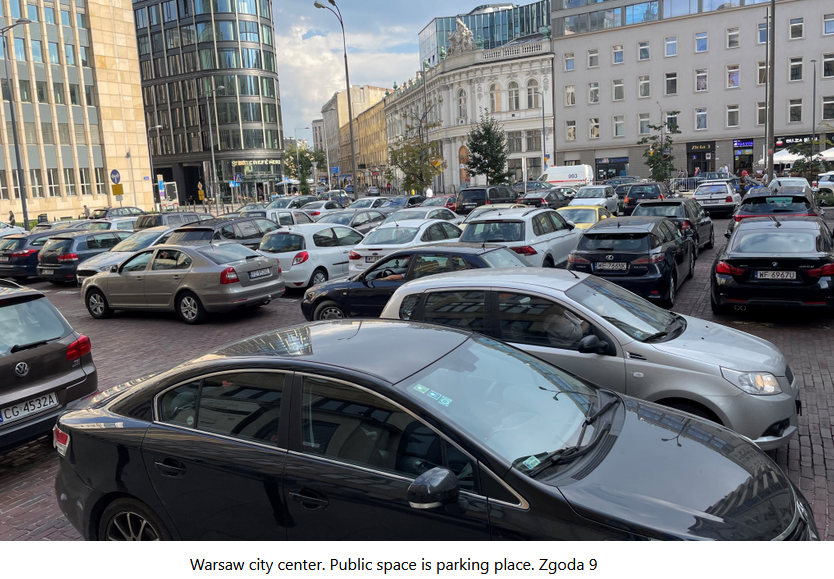
You fly a lot with your work. Many flights must be short-haul. In November 2019 you said you are Fine with Flying. Are you; still?
Yeah. Flying is 3% of global emissions. Road transport? Still increasing and going off the charts. We have a very-very big fish to fry. And that’s the one we should focus first on. If we talk about CO2 it is also buildings which are a huge chunk of the equasion. We have to make them more efficient and improve sustainability goals in the construction sector. There are so many really important things to do now. Flying is not one of them. I know what you mean. People say: flying, CO2. Yeah. But nobody ever calculates in the human aspect of it. All the young activists focus on business class travelers like on some evil tribe. But what does flying do is not considered. And yet it brings people and cultures together. It opens their minds. Cares for long-term relationships. Families. People living further apart than ever before. People who have to meet. Flying bridges Europe. Flying has an absolutely important sociological function as well.
Flying less is never a bad thing. But I live in Denmark where we do not have good rail connections further south. If I go to Sweden – great. But if I have to go to Berlin? It’s 7.5 hours on a train. If I want to fly? It’s 45 minutes. So if I visit Berlin for the weekend or for work there, I will fly. Of course. I have kids. 15 hours just traveling? I want to get there, come back and then be with my family. But every time I’m further south – for instance, I will fly to Amsterdam on Sunday – I will be taking the train to Paris. When later in the month I must visit Frankfurt, I will fly from Copenhagen but from Frankfurt, I will be taking the train to Paris. As soon as I can hit the train – efficient high-speed train – I am on it. It just doesn’t work from my location here. But hey! I’m still fine with flying. And everybody should be.
Rafał Kosmal


